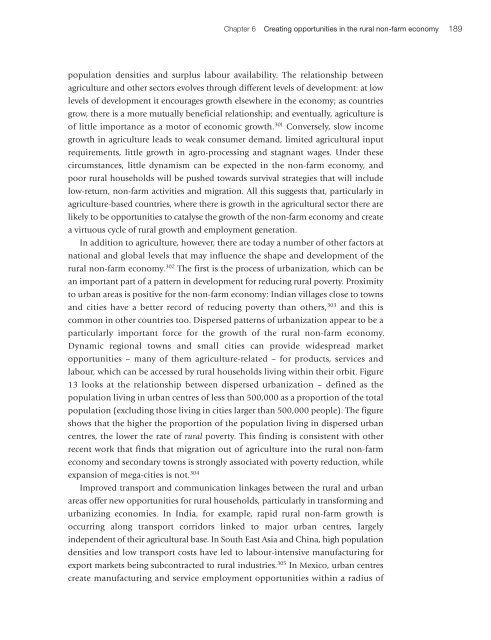English - IFAD
English - IFAD
English - IFAD
You also want an ePaper? Increase the reach of your titles
YUMPU automatically turns print PDFs into web optimized ePapers that Google loves.
Chapter 6 Creating opportunities in the rural non-farm economy 189<br />
population densities and surplus labour availability. The relationship between<br />
agriculture and other sectors evolves through different levels of development: at low<br />
levels of development it encourages growth elsewhere in the economy; as countries<br />
grow, there is a more mutually beneficial relationship; and eventually, agriculture is<br />
of little importance as a motor of economic growth. 301 Conversely, slow income<br />
growth in agriculture leads to weak consumer demand, limited agricultural input<br />
requirements, little growth in agro-processing and stagnant wages. Under these<br />
circumstances, little dynamism can be expected in the non-farm economy, and<br />
poor rural households will be pushed towards survival strategies that will include<br />
low-return, non-farm activities and migration. All this suggests that, particularly in<br />
agriculture-based countries, where there is growth in the agricultural sector there are<br />
likely to be opportunities to catalyse the growth of the non-farm economy and create<br />
a virtuous cycle of rural growth and employment generation.<br />
In addition to agriculture, however, there are today a number of other factors at<br />
national and global levels that may influence the shape and development of the<br />
rural non-farm economy. 302 The first is the process of urbanization, which can be<br />
an important part of a pattern in development for reducing rural poverty. Proximity<br />
to urban areas is positive for the non-farm economy: Indian villages close to towns<br />
and cities have a better record of reducing poverty than others, 303 and this is<br />
common in other countries too. Dispersed patterns of urbanization appear to be a<br />
particularly important force for the growth of the rural non-farm economy.<br />
Dynamic regional towns and small cities can provide widespread market<br />
opportunities – many of them agriculture-related – for products, services and<br />
labour, which can be accessed by rural households living within their orbit. Figure<br />
13 looks at the relationship between dispersed urbanization – defined as the<br />
population living in urban centres of less than 500,000 as a proportion of the total<br />
population (excluding those living in cities larger than 500,000 people). The figure<br />
shows that the higher the proportion of the population living in dispersed urban<br />
centres, the lower the rate of rural poverty. This finding is consistent with other<br />
recent work that finds that migration out of agriculture into the rural non-farm<br />
economy and secondary towns is strongly associated with poverty reduction, while<br />
expansion of mega-cities is not. 304<br />
Improved transport and communication linkages between the rural and urban<br />
areas offer new opportunities for rural households, particularly in transforming and<br />
urbanizing economies. In India, for example, rapid rural non-farm growth is<br />
occurring along transport corridors linked to major urban centres, largely<br />
independent of their agricultural base. In South East Asia and China, high population<br />
densities and low transport costs have led to labour-intensive manufacturing for<br />
export markets being subcontracted to rural industries. 305 In Mexico, urban centres<br />
create manufacturing and service employment opportunities within a radius of

















